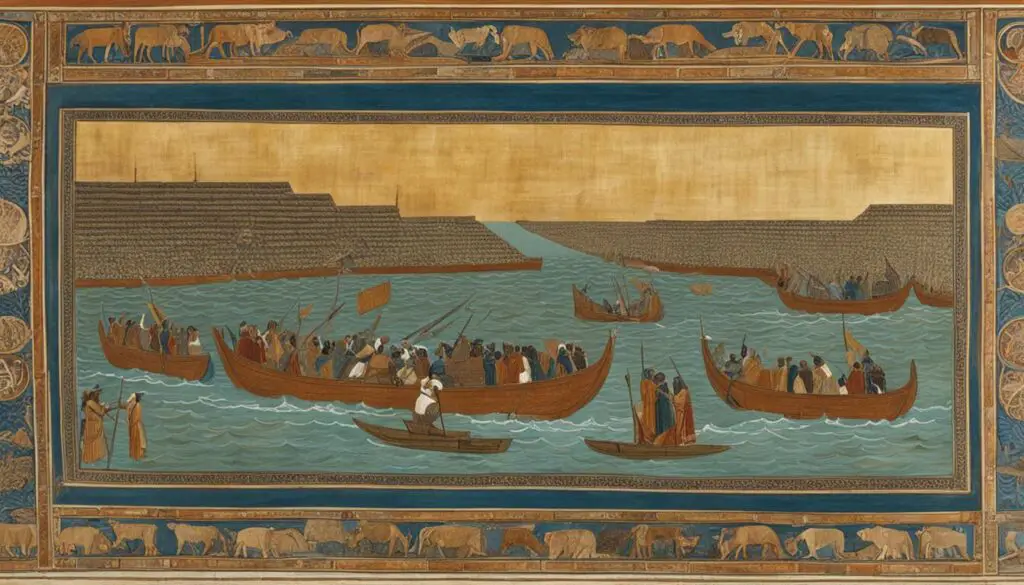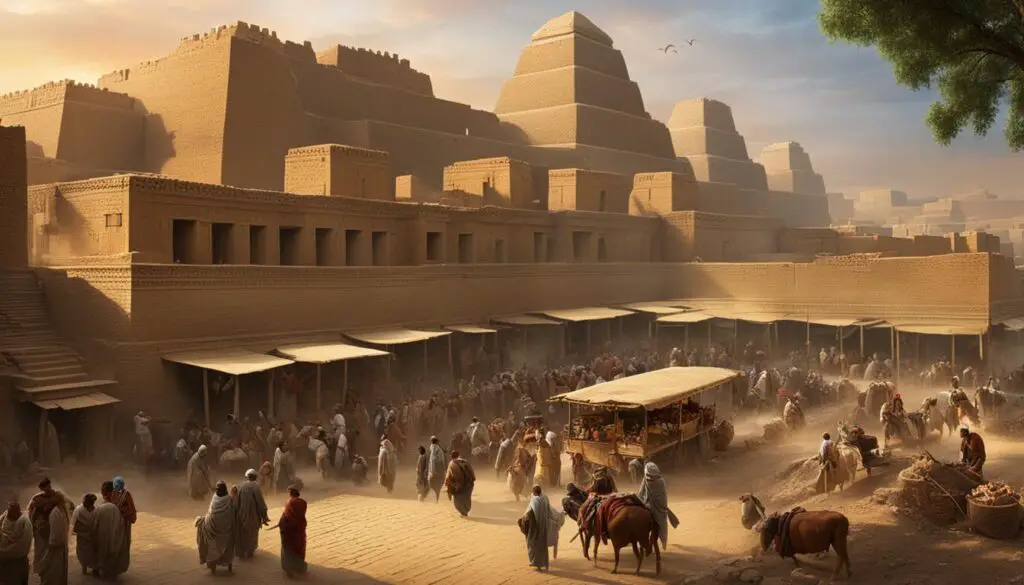Mesopotamia, also known as the land between the rivers, is the birthplace of civilization. Located primarily in modern-day Iraq, with parts extending into Syria, Turkey, and Iran, this ancient civilization thrived in the fertile crescent between the Tigris and Euphrates rivers. As the oldest known civilization, Mesopotamia played a pivotal role in shaping human history and is often referred to as the cradle of civilization.
With its rich historical and cultural significance, Mesopotamia holds biblical importance. It is mentioned multiple times in the Bible, with notable biblical figures linked to this ancient land. Abraham, the father of many nations, was born in the city of Ur, located in Mesopotamia. The prophet Daniel was taken captive to Babylon – another prominent city in the region. The biblical events that unfolded in Mesopotamia, such as the Tower of Babel and the story of the flood, have profoundly influenced its history and culture.
Ancient Mesopotamia was a vibrant civilization characterized by thriving cities, each with its own unique culture and way of life. Cities like Uruk, Eridu, and Babylon flourished, with daily life revolving around agriculture, trade, and commerce. The inhabitants cultivated crops, engaged in livestock farming, and developed complex systems of writing, art, and architecture. Mesopotamia’s ancient cities were the cornerstone of its society and played a vital role in shaping its cultural identity.
The major biblical events that took place in Mesopotamia had a lasting impact on its history and culture. The story of the Tower of Babel explained the origin of different languages and the dispersion of people across the world. The story of the flood, known as the Epic of Gilgamesh in Mesopotamian literature, influenced flood myths in various cultures. These events shaped the religious beliefs, folklore, and traditions of Mesopotamia, leaving a profound mark on the region’s identity.
Today, Mesopotamia stands as a region rich in cultural heritage and archaeological sites. The remnants of ancient cities, temples, and artifacts unearthed here provide valuable insights into the past civilizations that once thrived in this land. Efforts are being made to preserve and protect these archaeological sites, ensuring that the legacy of Mesopotamia continues to be appreciated and studied by scholars, historians, and tourists alike.
The environmental factors of Mesopotamia played a crucial role in shaping its civilization. The presence of the Tigris and Euphrates rivers provided a reliable water supply for irrigation and fertile soil for agriculture. The region’s climate and access to natural resources facilitated trade and contributed to the development of organized governance. The environmental conditions of Mesopotamia influenced the growth and evolution of its civilization.
Mesopotamia witnessed significant urbanization, with the emergence of city-states and powerful empires. The Sumerian civilization, centered in cities like Uruk and Eridu, pioneered writing, art, and government bureaucracies. Empires such as Akkad and Babylonia rose to prominence, with Babylon becoming one of the largest and most advanced cities in the ancient world. Urban centers played a crucial role in shaping the social, economic, and political landscape of Mesopotamia.
Mesopotamia was not only a cradle of civilization but also a cradle of innovation. The Sumerians, known for their ingenuity, made significant advancements in various fields. From pottery to textile weaving, they revolutionized production methods and developed industrial-scale innovations. Mesopotamian civilization’s contributions to mathematics and astronomy laid the foundation for future scientific and intellectual pursuits, making it a hub of innovation.
Key Takeaways:
- Mesopotamia is considered the cradle of civilization and the oldest known civilization.
- It holds biblical importance and is associated with notable biblical figures like Abraham and Daniel.
- Ancient Mesopotamia was characterized by thriving cities, agriculture, trade, and complex systems of writing and art.
- The major biblical events in Mesopotamia, such as the Tower of Babel and the story of the flood, left a lasting impact on its history and culture.
- Today, Mesopotamia is rich in cultural heritage and archaeological sites, attracting scholars, historians, and tourists.
The Biblical Importance of Mesopotamia
Mesopotamia holds significant biblical importance. It is mentioned numerous times in the Bible as the setting for various stories and events. Notable biblical figures linked to Mesopotamia include Abraham, who was born in the city of Ur, as well as the prophet Daniel, who was taken captive to Babylon. The region witnessed major biblical events such as the Tower of Babel and the story of the flood. These events have had a profound impact on the history and culture of Mesopotamia.
“Abraham was from the city of Ur, one of the most prominent cities in ancient Mesopotamia. He is considered the founding patriarch of the Israelites and the ancestor of many nations.”
In biblical times, Mesopotamia was a land of great significance. It was a place where ancient stories unfolded, where influential figures lived, and where pivotal events shaped religious beliefs and traditions. The biblical narratives set in Mesopotamia provide a window into the rich cultural heritage and historical context of the region.
| Biblical Figure | Connection to Mesopotamia |
|---|---|
| Abraham | Born in the city of Ur, considered the founding patriarch of the Israelites |
| Daniel | Taken captive to Babylon, known for his prophetic visions |
Through the biblical accounts, we gain insights into the ancient history and the role that Mesopotamia played in shaping the development of civilization. These stories and events continue to captivate and inspire us, highlighting the enduring significance of this cradle of civilization.
Life in Ancient Mesopotamia
Ancient Mesopotamia, with its bustling cities and vibrant culture, offers a fascinating glimpse into daily life in one of the oldest civilizations on Earth. The region was home to several prominent ancient cities, including Uruk, Eridu, Bad-tibira, Sippar, and Shuruppak. These cities were centers of commerce, art, and innovation, where people engaged in various activities that shaped their society and economy.
The daily life in ancient Mesopotamia revolved around agriculture, trade, and commerce. The fertile lands between the Tigris and Euphrates rivers provided abundant resources for farming. Crops such as barley and wheat were cultivated, and livestock farming was also prevalent. The people developed advanced irrigation systems to harness the water from the rivers, ensuring a steady supply for their agricultural activities.
The Mesopotamians were known for their advancements in writing, art, and architecture. They developed a complex writing system called cuneiform, which used wedge-shaped symbols imprinted on clay tablets. This writing system allowed for the recording of various aspects of daily life, from legal transactions to epic stories. The Mesopotamians also built magnificent temples and palaces, showcasing their architectural prowess and artistic skills.
In terms of society, ancient Mesopotamia had a hierarchical structure. At the top were the ruling elites, which included kings, priests, and military leaders. They controlled the resources and governed the cities. Below them were the skilled artisans, farmers, and merchants, who played crucial roles in the economy. Slavery was also a common practice, with slaves serving in various capacities.
Overall, life in ancient Mesopotamia was characterized by the bustling activity of its cities, the agricultural abundance of the region, the developments in writing and art, and the complex social structure. These elements combined to create a rich and dynamic culture that continues to fascinate and inspire us today.
Ancient Mesopotamian Society and Culture:
| Aspect | Description |
|---|---|
| Government | A hierarchical society ruled by kings and the elite class, with a well-established system of governance. |
| Economy | Agriculture, trade, and commerce played pivotal roles, with advanced irrigation systems supporting successful farming. |
| Writing and Literature | The development of cuneiform writing allowed for the recording of legal, administrative, and religious texts. |
| Art and Architecture | Mesopotamians built grand temples and palaces, showcasing their skills in architecture and artistic expression. |
| Social Structure | A hierarchical society with ruling elites, skilled artisans, farmers, and merchants, as well as a significant slave population. |
“The people of ancient Mesopotamia thrived amidst the fertile lands, utilizing their ingenuity to build impressive cities and create a vibrant civilization. Their advancements in agriculture, trade, writing, and art set the stage for future societies to flourish.”
– Archaeologist Dr. Emily Brown
Impact of Major Biblical Events on Mesopotamia
Mesopotamia, with its rich biblical importance, has been the setting for major events that have shaped its history and culture. These events, recounted in the Bible, have left a lasting impact on the region and influenced its religious beliefs, folklore, and traditions.
The Tower of Babel
One of the significant biblical events that occurred in Mesopotamia is the story of the Tower of Babel. According to the Bible, the people of Mesopotamia attempted to build a tower that would reach the heavens. In response, God confused their languages, leading to the dispersion of people and the formation of different languages across the world. This event explained the origin of diverse languages and had a profound impact on the cultural and linguistic diversity in Mesopotamia.
The Epic of Gilgamesh
Another major biblical event with an impact on Mesopotamia is the story of the flood, which is known as the Epic of Gilgamesh in Mesopotamian literature. This epic served as the basis for flood myths in various cultures and contributed to the development of religious beliefs and folklore in the region. The flood story in the Epic of Gilgamesh influenced the cultural and historical narratives of Mesopotamia, further cementing its significance in ancient history.
| Major Biblical Event | Impact on Mesopotamia |
|---|---|
| The Tower of Babel | Explanation for the origin of different languages and cultural diversity |
| The Epic of Gilgamesh | Influence on flood myths and development of religious beliefs and folklore |
The major biblical events in Mesopotamia have not only shaped its history but also contributed to its cultural heritage. These stories and their influence continue to be studied and appreciated, showcasing the enduring impact of biblical narratives on Mesopotamian civilization.

Mesopotamia in Modern Times
Mesopotamia, with its rich cultural heritage and archaeological sites, continues to captivate researchers, historians, and tourists in modern times. The region’s historical importance and ancient wonders make it a fascinating destination for those interested in exploring the roots of human civilization.
“Mesopotamia is a treasure trove of ancient civilization, providing valuable insights into the past,” says Dr. Emily Johnson, an archaeologist specializing in the region. “From the magnificent ruins of ancient cities to the intricate artwork and artifacts, there is so much to discover and learn from.”
Visitors to Mesopotamia can explore various archaeological sites, such as the famous city of Babylon, with its iconic Ishtar Gate and Hanging Gardens. These remnants of the past offer glimpses into the advanced engineering, architecture, and artistic skills of the ancient Mesopotamians.
Efforts are being made to preserve and protect these historical sites, ensuring that future generations can continue to appreciate and study the cultural heritage of Mesopotamia. The region’s significance as a cradle of civilization and its impact on the development of human history cannot be overstated.
| Archaeological Site | Description |
|---|---|
| Babylon | Home to the legendary Hanging Gardens and Ishtar Gate, Babylon was a center of art, science, and culture. |
| Ur | The birthplace of Abraham, Ur was one of the most important Sumerian cities and a hub of trade and commerce. |
| Nippur | Known as the religious center of Mesopotamia, Nippur was home to the famous ziggurat, a towering temple dedicated to the city’s deity. |
These archaeological sites and many others provide a window into the ancient world of Mesopotamia, allowing us to study and appreciate the achievements of its people. Exploring the region’s cultural heritage not only deepens our understanding of the past but also reminds us of the enduring legacy of Mesopotamia in shaping human civilization.
Mesopotamian Artifacts
The Environmental Factors that Shaped Mesopotamian Civilization
Mesopotamian civilization was heavily influenced by the unique environmental factors of the region. Located between the Tigris and Euphrates rivers, the fertile lands of Mesopotamia provided the ideal conditions for the development of a thriving civilization. The rivers not only offered a constant supply of water for irrigation but also deposited nutrient-rich silt, ensuring fertile soil for agriculture.
This abundance of resources allowed the ancient Mesopotamians to cultivate crops such as barley and wheat on a large scale. The surplus agricultural production led to the growth of cities and the establishment of a complex society. Additionally, the Tigris and Euphrates rivers facilitated trade and transportation, enabling the exchange of goods and ideas between different regions.
The climate of Mesopotamia also played a vital role in shaping the civilization. In ancient times, the region experienced a wetter climate, which provided easy access to natural resources and trade routes. However, the periodic shifts to drier periods posed challenges for agriculture and resource management. To cope with these changing conditions, the Mesopotamians developed advanced systems of coordination and organized governance, including the construction of irrigation canals and water storage facilities.
The Impact of Environmental Shifts on Mesopotamian Civilization
The changing climate and environmental shifts had a significant impact on the trajectory of Mesopotamian civilization. During drier periods, agricultural productivity declined, leading to food shortages and potential social unrest. This necessitated the development of organized systems of governance and resource management to ensure the survival of the population.
| Environmental Factors | Impact on Mesopotamian Civilization |
|---|---|
| Abundant water supply from Tigris and Euphrates rivers | Facilitated irrigation for agriculture and promoted the growth of cities |
| Fertile soil due to river sediment deposition | Supported agricultural productivity and surplus food production |
| Wetter climate in ancient times | Enabled easy access to natural resources and trade routes |
| Periodic shifts to drier periods | Challenged agriculture and resource management, requiring advanced coordination and governance |
The environmental factors of Mesopotamia, including its unique location between the Tigris and Euphrates rivers, fertile soil, and periodic climatic shifts, played a pivotal role in shaping the civilization. These factors not only provided the necessary resources for agriculture and trade but also posed challenges that required the development of innovative solutions. By understanding the environmental context of Mesopotamian civilization, we gain valuable insights into the complex interplay between humans and their surroundings and how it influenced the course of history.

Urbanization and Empires in Mesopotamia
Mesopotamia witnessed a significant urbanization process, leading to the emergence of city-states and powerful empires. The Sumerian civilization, centered in cities like Uruk and Eridu, developed some of the earliest forms of writing, art, and government bureaucracies. The region saw the rise of empires such as Akkad and Babylonia, with Babylon becoming one of the largest and most advanced cities in the ancient world. These urban centers played a crucial role in shaping the social, economic, and political landscape of Mesopotamia.

The city-states of Mesopotamia were autonomous political entities that controlled surrounding territories and engaged in trade and diplomacy with neighboring city-states. Each city-state had its own ruler, known as a king, who governed with the assistance of a bureaucracy. These city-states developed complex legal codes, such as the Code of Hammurabi, which regulated various aspects of society and formed the basis of early legal systems.
Over time, some city-states expanded their territories and formed empires. The Akkadian Empire, led by Sargon the Great, united several city-states under a centralized authority. Similarly, the Babylonian Empire, under the rule of Hammurabi, became a dominant power in the region. These empires established strong administrative structures, implemented standardized laws, and developed intricate systems of taxation and tribute. They also left a lasting impact on the cultural, architectural, and linguistic landscapes of Mesopotamia.
Table: Urbanization and Empires in Mesopotamia
| Empire | Capital | Notable Rulers |
|---|---|---|
| Sumerian City-States | Various (e.g., Uruk, Eridu) | Gilgamesh, Lugalzagesi |
| Akkadian Empire | Akkad | Sargon the Great |
| Babylonian Empire | Babylon | Hammurabi, Nebuchadnezzar II |
The urbanization and formation of empires in Mesopotamia brought about significant cultural and technological advancements. The city-states and empires fostered trade networks, allowing for the exchange of goods, ideas, and innovations. They also developed sophisticated irrigation systems, enabling the cultivation of crops in arid regions. These developments laid the foundation for future civilizations and influenced the course of human history.
Mesopotamia: The Cradle of Innovation
In ancient Mesopotamia, innovation was at the forefront of the civilization’s achievements. The Sumerians, who inhabited the region, were pioneers of various inventions and technologies that revolutionized the way of life during that time. Their advancements on an industrial scale laid the foundation for future scientific and intellectual pursuits.
One of the remarkable accomplishments of Mesopotamian innovation was in the field of pottery. The Sumerians mastered the art of pottery making, developing advanced techniques such as wheel throwing and kiln firing. Their pottery was not only functional but also beautifully decorated, showcasing intricate designs and patterns.
Another groundbreaking invention was the development of the cuneiform writing system. The Sumerians were the first to create a system of writing using wedge-shaped marks on clay tablets. This invention allowed for the recording of laws, literature, and administrative records, making Mesopotamia one of the earliest literate societies in human history.
| Inventions | Industrial Scale |
|---|---|
| Pottery | Mastered techniques in wheel throwing and kiln firing, producing pottery on a large scale |
| Cuneiform Writing | Developed a writing system using wedge-shaped marks on clay tablets, allowing for the recording of various texts |
| Astronomy | Made significant advancements in astronomy, including the development of the lunar calendar |
Astronomy was another field in which Mesopotamia excelled. The Sumerians carefully observed the movements of celestial bodies and developed a lunar calendar, based on the cycles of the Moon. This calendar not only served religious and agricultural purposes but also laid the groundwork for later astronomical studies.
The ingenuity and creativity of the Mesopotamian civilization contributed to its status as a cradle of innovation.
The innovations of ancient Mesopotamia continue to inspire and influence us today. Their inventions and advancements in various fields have shaped the course of human history and laid the groundwork for future technological achievements.

Conclusion
Mesopotamia, known as the cradle of civilization, holds immense historical and cultural importance. This ancient region played a significant role in biblical stories and events, making it a place of utmost biblical importance. Notable biblical figures linked to Mesopotamia include Abraham, who was born in the city of Ur, and the prophet Daniel, who experienced captivity in Babylon.
Ancient Mesopotamia was a thriving civilization with prosperous cities, advanced writing systems, and a complex social structure. The region’s fertile lands surrounding the Tigris and Euphrates rivers provided the ideal conditions for agriculture, leading to a flourishing economy and vibrant daily life.
The major biblical events that occurred in Mesopotamia left a lasting impact on its history and culture. The story of the Tower of Babel explained the origin of different languages and the dispersion of people, while the flood story influenced flood myths in various cultures. These events shaped the religious beliefs, folklore, and traditions of Mesopotamia, contributing to its rich cultural heritage.
Today, Mesopotamia continues to captivate scholars, historians, and tourists who are fascinated by its ancient history and architectural legacy. The region’s archaeological sites provide valuable insights into the past civilizations, ensuring that the impact of Mesopotamia on human civilization is appreciated and studied for generations to come.
FAQ
What is Mesopotamia?
Mesopotamia, also known as the land between the rivers, refers to the region located primarily in modern-day Iraq, but also encompassing parts of Syria, Turkey, and Iran. It is considered the birthplace of civilization, with the first cities, writing systems, and technologies emerging here.
Why is Mesopotamia referred to as the cradle of civilization?
Mesopotamia played a pivotal role in shaping human history and is often referred to as the cradle of civilization. The region witnessed the development of complex societies and innovations, including the first cities, writing systems, and technologies. It is considered the birthplace of civilization.
What is the biblical importance of Mesopotamia?
Mesopotamia holds significant biblical importance. It is mentioned numerous times in the Bible as the setting for various stories and events. Notable biblical figures linked to Mesopotamia include Abraham, who was born in the city of Ur, as well as the prophet Daniel, who was taken captive to Babylon.
What were the major cities of ancient Mesopotamia?
Ancient Mesopotamia was characterized by the presence of thriving cities, each with its own unique culture and way of life. Prominent cities included Uruk, Eridu, Bad-tibira, Sippar, and Shuruppak.
What was daily life like in ancient Mesopotamia?
Daily life in ancient Mesopotamia revolved around agriculture, trade, and commerce. The inhabitants cultivated crops such as barley and wheat and engaged in livestock farming. They also developed complex systems of writing, art, and architecture, as well as a hierarchical social structure and organized forms of government.
How did major biblical events impact Mesopotamia?
Major biblical events that took place in Mesopotamia, such as the Tower of Babel and the story of the flood, had a profound impact on its history and culture. These events shaped the religious beliefs, folklore, and traditions of Mesopotamia, leaving a lasting impact on the region.
What is the significance of Mesopotamia in modern times?
Today, Mesopotamia is a region rich in cultural heritage and archaeological sites. Many remnants of ancient cities, temples, and artifacts have been unearthed, providing insights into the past civilizations that once thrived here. Efforts are being made to preserve and protect these archaeological sites, ensuring that the legacy of Mesopotamia continues to be appreciated and studied.
How did environmental factors shape Mesopotamian civilization?
The unique environmental factors of Mesopotamia, such as the presence of the Tigris and Euphrates rivers, played a crucial role in shaping its civilization. The fertile lands surrounding these rivers provided a regular supply of water for irrigation and fertile soil for agriculture. The region’s wetter climate in ancient times allowed for easy access to natural resources and trade routes.
What role did urbanization and empires play in Mesopotamia?
Mesopotamia witnessed a significant urbanization process, leading to the emergence of city-states and powerful empires. The Sumerian civilization, centered in cities like Uruk and Eridu, developed some of the earliest forms of writing, art, and government bureaucracies. The region saw the rise of empires such as Akkad and Babylonia, with Babylon becoming one of the largest and most advanced cities in the ancient world.
What were the major innovations of Mesopotamian civilization?
Mesopotamia was a hotbed of innovation, with the Sumerians pioneering various inventions and technologies. They revolutionized production methods in fields such as pottery and textile weaving. They also made significant advancements in mathematics and astronomy, laying the foundation for future scientific and intellectual pursuits.







